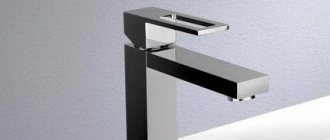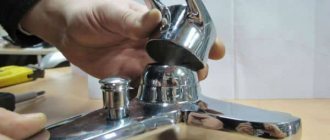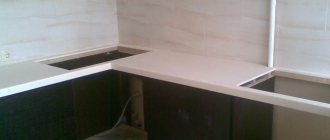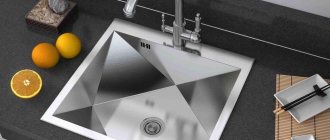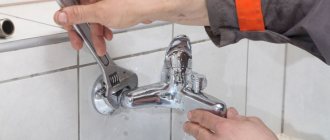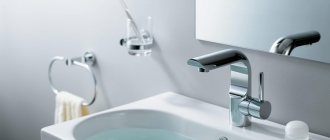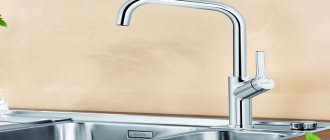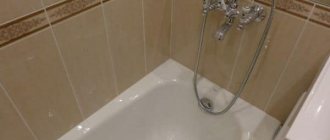/Repair/Plumbing/
So, you bought a faucet to replace an old one or to equip a sink with a new set and decided to take on the installation yourself. On the one hand, connecting and installing a faucet on the sink with your own hands is very simple - anyone can do it. On the other hand, even having some experience, but not knowing the basic rules, you can do the work poorly or completely ruin the product, for example, by knocking off the thread, bending the connections, etc. Another reason why you still have to contact a plumber is this is the lack of a set of plumbing tools. But this problem is completely solvable, because you can always ask your friends for something.
We tried to explain as clearly as possible how to install a faucet in the kitchen with your own hands, reliably and correctly.
List of required tools and spare parts
Before you begin installing kitchen plumbing with your own hands, you need to prepare and purchase everything you need. You will need:
- FUM sealing tape - it’s better not to use flax tow, as it swells with water, and then it will be difficult to remove the liners;
- Open-end wrench 10 or 11;
- Tubular wrench – needed to tighten a hard-to-reach nut when installing the faucet to the sink;
- Installation kit - it should contain rubber O-rings, that is, half washers (2 pcs.), one horseshoe-shaped metal half washer, a stud (1 or 2) and a nut. This set is included with the mixer, but if you wish, you can buy a thicker and stronger O-ring, since manufacturers do not always include high-quality gaskets in the kit;
- Pliers, a small wrench, a screwdriver - sometimes these are also needed;
- A rag, a basin and a flashlight will also come in handy so that you can see everything;
- And finally, the main thing - 2 plumbing connections - are included in the kit, but it is better to buy others, since the factory ones are often short and made of silumin;
Perhaps it’s worth paying attention to the eyeliners. Keep in mind that:
- The eyeliners need to be of such length that they do not break, but bend in the form of a semicircle, that is, they should not be too long or, conversely, short when tight. The most common length is 86 cm;
- If the factory eyeliner is too short, then it is better not to try to extend it, but to buy a new one;
- In addition, do not buy silumin hoses, especially if you bought a silumin mixer - at least the connections should be reliable;
- Installation of flexible hoses is easier than connecting rigid ones, but they are considered less reliable, so it is better to install them together with tap taps;
- The set of eyeliners must include gaskets;
- Replacing an old faucet in the kitchen most often involves replacing the old connections, because they also wear out.
How to choose a kitchen faucet?
On sale you can find a huge number of different options for mixers, which differ in design features and materials of manufacture.
Previously, most products were made of durable metal, and they were wear-resistant. Now cheaper and lighter alloys, such as silumin, are often used in production.
The silumin mixer looks nice, but is not reliable
Such designs will definitely not serve you for many years, but at the same time they have a minimal cost. Installing a cheap faucet is dangerous, because it can suddenly leak when the residents are not in the apartment, which is fraught with big problems.
This is why experts recommend purchasing high-quality products, despite the fact that they have a higher price. You can distinguish a reliable mixer by its weight - any brass structures are an order of magnitude heavier than silumin ones.
Table No. 1. The most popular faucet designs.
| View, illustration | Description |
| With one lever (cartridge) | The mixer is designed in such a way that there is a cartridge inside it. When the lever is lifted, the valve opens and tap water flows. The water temperature changes by manually turning the lever to one side. Such a mixer is unsuitable if a flow-through water heater with the ability to change the temperature regime is installed, since it is impossible to smoothly adjust this lever. Otherwise, this type of mixer is convenient for the kitchen, because it can be operated with one hand, which is extremely important during the cooking process. |
| With two valves | This design has been used for a long time, so of all the possible options it is the most practical. In this case, shut-off valves are attached to individual channels, and to supply water you will need to open one of the valves (from either side). It is worth noting that this design consumes much more water compared to the previous option. |
| Sensory | This is the most modern type of design. The sensor is triggered by hand movements, due to which the magnetic valve opens and water is supplied. This is very convenient for the housewife, because she doesn’t have to dirty the tap with dirty hands. However, such a product has two significant disadvantages. The first is high cost. Secondly, the mixer will not function without electricity, and if the lights go out, it will not be possible to turn on the water. |
With retractable watering can | This type of faucet will be needed only if the housewife needs to wash a large amount of dishes every day (if she has a large sink). In other cases, its installation will be unprofitable. |
When purchasing a mixer, you should pay attention to the following nuances:
- Sink dimensions. Based on the size of the sink, you should choose the optimal length and height of the tap. So, according to the standard, the stream of water that comes out of the tap should fall into the middle of the sink. The height of the spout should be positioned in such a way that the mixer is comfortable to use. However, the jet cannot be too high, otherwise the water will only splash on the sides along with greasy drops from the dishes.
- The location of the recess for installation and its diameter. To avoid having to enlarge the hole in the sink, you should choose the appropriate flange size. If you have an atypical hole, you will need to purchase an adapter.
- Rotate the tap. The choice of the optimal option will depend on the number of sinks. So, if there is only one sink, then a 90-degree turn is sufficient. If you have two sinks, it is better to choose a mixer with a 180-degree rotation.
- Appearance of the product. For many, this nuance is of great importance, because the mixer must be combined with the sink. If desired, you can purchase chrome or matte products, or to match the color of the sink itself.
The modern market offers faucets to suit any kitchen design
Basic criteria for choosing a kitchen sink
Step 1. Dismantling the old mixer and preparing for installation
Before installing a faucet in the kitchen, you need to turn off the water (there is no need to turn off the riser) and, just in case, put a rag on the bottom of the sink so that small parts do not fall into it, and large parts do not damage it.
Of course, replacing a kitchen faucet requires dismantling the old faucet. To do this you need:
- First, disconnect the old hoses from the cold and hot water pipes by hand or with an open-end wrench. Do not forget to place a basin under them and drain all the remaining water, after which the threads of the pipes must be wiped clean.
- Then, using a tubular wrench, you need to unscrew the clamping nut on the stud (or two studs), which secures the faucet to the sink (right under it). When you unscrew this nut, the metal half washer will also come off.
- Now you need to pull out the mixer along with the hoses from the sink hole. Well, that's all, you can proceed to the next step.
Mounting the device on a wall
Installing a faucet into the wall is a rather original solution for the kitchen interior. In this case, the crane will occupy a minimum of working space. Appropriate cutouts are first made in the tile or wall through which the connection will be made.
This type of installation looks quite aesthetically pleasing. In some cases, the pipes from the wall are brought outside, but this option is detrimental to the interior of the kitchen; it is better to hide all the pipes behind the wall.
Wall mounting does not require the use of flexible hoses. The main difficulty is to remove the pipes and cover them behind a layer of finishing
Installing the mixer on the wall requires appropriate water supply with the elements for connection to the outside. The connection method is the same for iron, plastic, copper or metal-plastic pipes, with the exception of the use of adapters and fittings.
The connection method is also not affected by the type of mixer (valve, cartridges, etc.). A prerequisite is the selection of a wall-mounted mixer, the design of which involves installation in the wall.
For installation on iron pipes, tees and angles are used. If the axes of the connectors for connecting the mixer coincide with the axes of the pipes, then it is enough to use couplings. To connect to other types of pipes, special fittings are used, which are also called water sockets.
Features of wall-mounted mixers
These models can be mounted at any height. Faucets are available with flexible and rigid spouts. Flexible ones have many position variations that allow you to perform any task in the kitchen. Products with a rigid spout require limited travel and rotation of the mixer.
The design of wall-mounted faucets is varied, as are their external design features. The photo shows a chrome-plated device with a flexible spout and aerator
For most kitchens, wall-mounted models are a fairly convenient and practical solution.
Connection sequence
First you need to screw on the eccentrics that connect the mixer to the pipes. To avoid increased condensation formation, the distance between the pipe axes should be 150 mm.
Most wall mixers are produced with exactly this distance between the eccentrics. You need to wrap tow (linen or synthetic) around the threads.
Threaded connections wrapped in tow or linen thread and then treated with sealant last longer and do not allow water to pass through
Next, screw the faucet nuts onto the eccentrics and install the decorative screen (overlay). It is carefully screwed on by hand, as it must fit snugly to the surface of the wall.
If the gap is no more than 5 mm, then you can disconnect the mixer and cut the eccentrics to the appropriate length. The decorative panel hides all imperfections on the wall.
Next, you should install the gaskets, which are included with the mixer and can be made of silicone, paronite, rubber and other polymer materials.
Gaskets are inserted into the housing nuts, ensuring a tight fit to the eccentrics. For maximum density, there should be no cracks on the eccentric. An uneven cut surface can be sanded with sandpaper.
The last stage is tightening the nuts: first with your hands, and when your own efforts are no longer enough, you need to tighten the connections with an adjustable wrench. The efforts should not be excessive so as not to damage the threads.
Company's own technologies
In the manufacture of sanitary fittings for the kitchen, German engineers developed a number of interesting solutions. Thus, the Grohe Eurosmart faucet, in addition to its original appearance, has a proprietary StarLight® coating.
The surface of the product is not only resistant to moisture and detergents, but practically no deposits form on it. The faucet retains its appearance for a long time.
The cartridge used in the product is also unique; it is made from ceramics. The material has the highest degree of chemical inertness towards water. The technology was developed by the company’s specialists and patented by them under their own name SilkMove®.
Grohe Euroeco 32752000 tap – high quality
No less interesting is another product from the company labeled Grohe Euroeco 32752000. This mixer has a number of extremely useful properties. The tall water spout can be rotated in a full circle.
The cartridge allows for smooth adjustment of water flow and temperature by operating one single lever. The relatively low price makes the product accessible to many.
Schematic representation of the model in question
All products of this German company supplied to our country are manufactured in accordance with European quality standards. They are designed for long-term operation without significant changes in consumer properties.
The delivery set contains everything necessary for installation, which can be done with your own hands without the involvement of personnel from housing maintenance organizations.
As practice shows, the owner is always able to do this simple work better than hired specialists. Quality Grohe kitchen taps are recommended for their intended use.
Installation is simple, and further operation of such products will satisfy any consumer with its simplicity and practicality.
Did you like the article? Subscribe to our Yandex.Zen channel
Great article 0
Preparatory stage
- First, you should turn off the water supply from the central riser, otherwise you can run into big trouble - you will have to eliminate the flooding. Then you need to open the tap so that the remaining water flows out of the mixer.
- You should prepare the tools and materials that will be needed for replacement. It would also be a good idea to study the passport and instructions for the purchased kitchen faucet.
Tools and materials needed for work
To change the faucet you don’t need any fancy devices. In most cases it is enough:
- an adjustable wrench (in some cases, if you don’t have one, you can use a wrench);
- flat screwdriver;
- Phillips screwdriver;
- flashlight;
- sandpaper.
It is better to change the mixer immediately with flexible hoses
Recommendation! If the previous mixer was an inexpensive model, it is recommended to also replace the flexible hoses connecting it to the water supply. Most high-quality models have good hoses, which during the replacement period will still be in excellent condition and suitable for further use. But there is a risk that they will fail faster than the newly purchased mixer. That is why it is advisable to change these products too.
In addition, it is worth preparing a small container into which you will need to pour water from the siphon. It will not be superfluous to use a cleaning product in order to clean under the faucet, as well as under the sink, along with the replacement.
Sealant will be needed during installation of the sink, including for threaded connections.
Important! In the case of a removable sink, and not a mortise one, there is a possibility that it will need to be removed to dismantle the old one, as well as install the purchased faucet. It will be much more convenient
Other additional tools and fasteners may be required, etc.
First of all, you need to buy a new mixer and prepare the necessary materials and tools. After this, you should use a flashlight and look under the sink to inspect the work area.
The process can be roughly divided into dismantling an outdated faucet, as well as installing a new one.
Technological nuances of installation
When solving the problem of how to connect a sink faucet, some difficulties may arise that have a significant impact on the quality of the work performed. For example, the joints of flexible hoses can become very sticky, and the use of special tools does not give the desired result. In addition, sometimes the diameter of the cut-in hole may need to be adjusted or the faucet may need to be mounted on a countertop.
In this case, you can use a jigsaw and cut a new hole. In addition, it is necessary to check the condition and functionality of the water pipes and all wiring. If necessary, these elements need to be modified or completely replaced.
To independently install and connect a kitchen faucet, it is enough to study materials on the relevant topic, and professional craftsmen will help solve complex problems.
Production of sanitary devices: requirements for materials
Water is a universal solvent and upon contact with almost any object, impurities are formed. This is especially true for liquids with high temperatures; it is widely known that this increases the intensity of chemical reactions.
Therefore, even at the product development stage, the use of exceptionally high quality materials is envisaged. The development of special alloys is carried out in accordance with regulatory documents.
The Federal Republic of Germany has developed the DIN 50930-6 standard, which implements the provisions of the EDWD (European Drinking Water Directive). This document sets out the requirements for metals used in the production of products such as Grohe kitchen faucets and other fittings. To produce products that come into contact with drinking water, the company's factories use bronze and brass.
Kitchen faucet from Grohe
In order to reduce the content of heavy metal impurities, the requirements for alloys in terms of nickel and lead content have been tightened. As for non-metallic materials in contact with liquid, their characteristics are regulated by no less stringent requirements of the relevant standards.
In addition to raw materials, production processes at the company’s enterprises are also certified.
Elegant high-tech faucet

